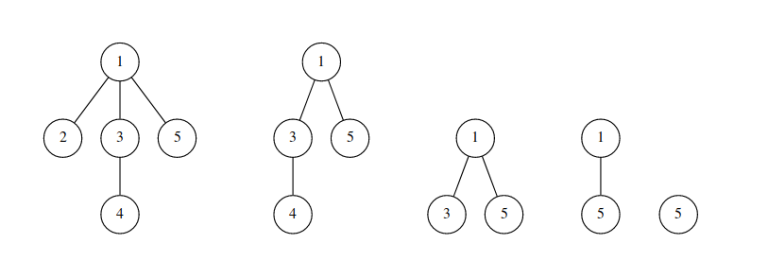CF1137F Matches Are Not a Child's Play(树链剖分)
题面
我们定义一棵树的删除序列为:每一次将树中编号最小的叶子删掉,将该节点编号加入到当前序列的最末端,最后只剩下一个节点时将该节点的编号加入到结尾。

例如对于上图中的树,它的删除序列为:2 4 3 1 5
现在给出一棵\(n\)个节点的树,有\(m\)次操作:
\(up\) \(v\):将\(v\)号节点的编号变为当前所有节点编号的\(\max + 1\)
\(when\) \(v\):查询\(v\)在当前树的删除序列中是第几号元素
\(compare\) \(u\) \(v\):查询\(u\)和\(v\)在当前树的删除序列中谁更靠前
题解
放火烧山,牢底坐穿
首先我们考虑一下,设当前树上优先度最高的点为\(u\),此时一个\(up\)操作,使得\(v\)成为了优先度最高的点,那么这棵树烧起来的时候会发生什么事
首先\(uv\)之间这条路肯定会最后才烧着,而且是从\(u\)烧到\(v\),而其它所有节点烧的相对顺序都是不变的
那么可以理解为,我们定义一个时间戳\(tim\),每次\(up\)操作的时候\(++tim\),并记录一下这个时间戳路径的起点\(u\),然后把\(uv\)路径上全都覆盖上这个时间戳。那么,一个节点第几个被烧呢?显然就是所有时间戳小于它的点的点数,再加上它到自己时间戳的起点\(u\)的距离
每一次都是区间覆盖,有没有让你想到什么呢?
对,这很像珂朵莉树。我们可以先树剖,对于每一条重链,维护一个\(set\),\(set\)里维护这条重链上的颜色区间。那么一次区间覆盖只要把旧的区间删去,并加入新的区间就行了。不过因为要维护每种颜色的点的个数,所以我们可能还需要用一个树状数组,再删除和插入区间的时候维护一下点的个数
还有个问题是我们需要算出一开始的答案,直接把每个点暴力\(up\)就行了
虽然说着像珂朵莉树不过这里的复杂度应该是严格的。每一次路径修改会被拆成\(O(\log n)\)个区间,每个被拆出来的区间最多插入一次删除一次。以及我们中间有可能需要把一个区间拆成两半,一次是询问的时候要把一个点拆出来看看它的时间戳是啥,那么这一部分拆出的区间总数是\(O(n)\)的。还有就是我们插入区间的时候有可能会拆掉区间,不过这种情况下拆出的区间最多一个,所以一次路径覆盖最多会拆出\(O(\log n)\)的区间,和前面的复杂度相同,再加上\(set\)和树状数组,时间复杂度应该是\(O(n\log^2 n)\)(大概没算错?)
//minamoto
#include<bits/stdc++.h>
#define R register
#define IT set<node>::iterator
#define fp(i,a,b) for(R int i=(a),I=(b)+1;i<I;++i)
#define fd(i,a,b) for(R int i=(a),I=(b)-1;i>I;--i)
#define go(u) for(int i=head[u],v=e[i].v;i;i=e[i].nx,v=e[i].v)
template<class T>inline bool cmax(T&a,const T&b){return a<b?a=b,1:0;}
using namespace std;
char buf[1<<21],*p1=buf,*p2=buf;
inline char getc(){return p1==p2&&(p2=(p1=buf)+fread(buf,1,1<<21,stdin),p1==p2)?EOF:*p1++;}
int read(){
R int res,f=1;R char ch;
while((ch=getc())>'9'||ch<'0')(ch=='-')&&(f=-1);
for(res=ch-'0';(ch=getc())>='0'&&ch<='9';res=res*10+ch-'0');
return res*f;
}
int read(char *s){
R int len=0;R char ch;while(((ch=getc())>'z'||ch<'a'));
for(s[++len]=ch;(ch=getc())>='a'&&ch<='z';s[++len]=ch);
return s[len+1]='\0',len;
}
char sr[1<<21],z[20];int C=-1,Z=0;
inline void Ot(){fwrite(sr,1,C+1,stdout),C=-1;}
void print(R int x){
if(C>1<<20)Ot();if(x<0)sr[++C]='-',x=-x;
while(z[++Z]=x%10+48,x/=10);
while(sr[++C]=z[Z],--Z);sr[++C]='\n';
}
const int N=5e5+5;
struct node{
int l,r,c;
node(){}
node(R int ll,R int rr=-1,R int cc=N){l=ll,r=rr,c=cc;}
inline bool operator <(const node &b)const{return l<b.l;}
};set<node>pool[N],*s[N];
struct eg{int v,nx;}e[N<<1];int head[N],tot;char t[25];
int dfn[N],sz[N],son[N],fa[N],top[N],dep[N],bg[N],c[N],mx[N];
int n,m,cnt,tim,las;
inline void add(R int u,R int v){e[++tot]={v,head[u]},head[u]=tot;}
inline void upd(R int x,R int y){for(;x<N;x+=x&-x)c[x]+=y;}
inline int ask(R int x){R int res=0;for(;x;x-=x&-x)res+=c[x];return res;}
IT split(set<node> *s,int pos){
IT it=s->lower_bound(node(pos));
if(it!=s->end()&&it->l==pos)return it;
--it;int l=it->l,r=it->r,c=it->c;
s->erase(it),s->insert(node(l,pos-1,c));
return s->insert(node(pos,r,c)).first;
}
void ins(set<node> *s,int l,int r,int c){
IT itr=split(s,r+1),itl=split(s,l);
for(IT it=itl;it!=itr;++it)upd(it->c,-(it->r-it->l+1));
upd(c,r-l+1);
s->erase(itl,itr),s->insert(node(l,r,c));
}
void dfs1(int u){
sz[u]=1,dep[u]=dep[fa[u]]+1;
go(u)if(v!=fa[u]){
fa[v]=u,dfs1(v),sz[u]+=sz[v];
sz[v]>sz[son[u]]?son[u]=v:0;
}
}
void dfs2(int u,int t){
top[u]=t,mx[u]=dfn[u]=++cnt;
if(son[u])dfs2(son[u],t),cmax(mx[u],mx[son[u]]);
if(u==t)s[u]=&pool[u],s[u]->insert(node(dfn[u],mx[u]+1));
go(u)if(!top[v])dfs2(v,v);
}
int LCA(int u,int v){
while(top[u]!=top[v]){
if(dep[top[u]]<dep[top[v]])swap(u,v);
u=fa[top[u]];
}
return dep[u]<dep[v]?u:v;
}
inline int dis(R int u,R int v){return dep[u]+dep[v]-(dep[LCA(u,v)]<<1)+1;}
void update(int u,int v){
bg[++tim]=u;
while(top[u]!=top[v]){
if(dep[top[u]]<dep[top[v]])swap(u,v);
ins(s[top[u]],dfn[top[u]],dfn[u],tim);
u=fa[top[u]];
}
if(dep[u]>dep[v])swap(u,v);
ins(s[top[u]],dfn[u],dfn[v],tim);
}
int query(int u){
int c=split(s[top[u]],dfn[u])->c;
return ask(c-1)+dis(u,bg[c]);
}
int main(){
// freopen("testdata.in","r",stdin);
n=read(),m=read();
for(R int i=1,u,v;i<n;++i)u=read(),v=read(),add(u,v),add(v,u);
dfs1(1),dfs2(1,1),las=n;
fp(i,1,n-1)update(i,i+1);
for(R int T=1,u,v;T<=m;++T){
read(t),u=read(),t[1]=='c'?v=read():0;
switch(t[1]){
case 'u':update(las,u),las=u;break;
case 'w':print(query(u));break;
case 'c':print(query(u)<query(v)?u:v);break;
}
}
return Ot(),0;
}
upd:为了卡常改了改代码,下面这份已经不能看了(然而还是被写\(LCT\)的聚聚们吊起来打)
下面这个加了一点优化,具体就是
1.一开始的时候不暴力\(up\),从大到小染色,那么每个点最多只会被染色一次
2.区间推倒……啊呸推平的时候判一下左右端点是不是刚好卡到边界(不过并没有什么卵用就是了)
//minamoto
#include<bits/stdc++.h>
#define R register
#define IT set<node>::iterator
#define fp(i,a,b) for(R int i=(a),I=(b)+1;i<I;++i)
#define fd(i,a,b) for(R int i=(a),I=(b)-1;i>I;--i)
#define go(u) for(int i=head[u],v=e[i].v;i;i=e[i].nx,v=e[i].v)
template<class T>inline bool cmax(T&a,const T&b){return a<b?a=b,1:0;}
using namespace std;
char buf[1<<21],*p1=buf,*p2=buf;
inline char getc(){return p1==p2&&(p2=(p1=buf)+fread(buf,1,1<<21,stdin),p1==p2)?EOF:*p1++;}
int read(){
R int res,f=1;R char ch;
while((ch=getc())>'9'||ch<'0')(ch=='-')&&(f=-1);
for(res=ch-'0';(ch=getc())>='0'&&ch<='9';res=res*10+ch-'0');
return res*f;
}
inline char getop(){R char ch;while((ch=getc())>'z'||ch<'a');return ch;}
char sr[1<<21],z[20];int C=-1,Z=0;
inline void Ot(){fwrite(sr,1,C+1,stdout),C=-1;}
void print(R int x){
if(C>1<<20)Ot();if(x<0)sr[++C]='-',x=-x;
while(z[++Z]=x%10+48,x/=10);
while(sr[++C]=z[Z],--Z);sr[++C]='\n';
}
const int N=5e5+5;
struct node{
int l,r,c;
node(){}
node(R int ll,R int rr=-1,R int cc=N){l=ll,r=rr,c=cc;}
inline bool operator <(const node &b)const{return l<b.l;}
};set<node>pool[N],*s[N];
struct eg{int v,nx;}e[N<<1];int head[N],tot;char op;
int dfn[N],sz[N],son[N],fa[N],top[N],dep[N],bg[N],c[N],mx[N],ga[N],col[N];
int n,m,cnt,tim,las,lim,num;
inline void add(R int u,R int v){e[++tot]={v,head[u]},head[u]=tot;}
inline void upd(R int x,R int y){for(;x<lim;x+=x&-x)c[x]+=y;}
inline int ask(R int x){R int res=0;for(;x;x-=x&-x)res+=c[x];return res;}
inline int find(int x){return ga[x]==x?x:ga[x]=find(ga[x]);}
inline set<node> *newnode(){return &pool[++num];}
IT split(set<node> *s,int pos){
IT it=s->lower_bound(node(pos));
if(it!=s->end()&&it->l==pos)return it;
--it;int l=it->l,r=it->r,c=it->c;
s->erase(it),s->insert(node(l,pos-1,c));
return s->insert(node(pos,r,c)).first;
}
void ins(set<node> *s,int l,int r,int id,int c){
upd(c,r-l+1);
if(l==dfn[id]&&r==mx[id]){
for(IT it=s->begin();it!=s->end();++it)upd(it->c,-(it->r-it->l+1));
s->erase(s->begin(),s->end()),s->insert(node(l,r,c));
return;
}
if(l==dfn[id]){
IT itr=split(s,r+1);
for(IT it=s->begin();it!=itr;++it)upd(it->c,-(it->r-it->l+1));
s->erase(s->begin(),itr),s->insert(node(l,r,c));
return;
}
if(r==mx[id]){
IT itl=split(s,l);
for(IT it=itl;it!=s->end();++it)upd(it->c,-(it->r-it->l+1));
s->erase(itl,s->end()),s->insert(node(l,r,c));
return;
}
IT itr=split(s,r+1),itl=split(s,l);
for(IT it=itl;it!=itr;++it)upd(it->c,-(it->r-it->l+1));
s->erase(itl,itr),s->insert(node(l,r,c));
}
void dfs1(int u){
sz[u]=1,dep[u]=dep[fa[u]]+1;
go(u)if(v!=fa[u]){
fa[v]=u,dfs1(v),sz[u]+=sz[v];
sz[v]>sz[son[u]]?son[u]=v:0;
}
}
void dfs2(int u,int t){
top[u]=t,mx[u]=dfn[u]=++cnt;
if(son[u])dfs2(son[u],t),cmax(mx[u],mx[son[u]]);
if(u==t)s[u]=newnode();
go(u)if(!top[v])dfs2(v,v);
}
void dfs3(int u,int t,int mn){
if(!son[u]||col[son[u]]!=col[mn])s[t]->insert(node(dfn[mn],dfn[u],col[u])),upd(col[u],dfn[u]-dfn[mn]+1);
if(son[u])dfs3(son[u],t,col[mn]==col[son[u]]?mn:son[u]);
go(u)if(v!=fa[u]&&v!=son[u])dfs3(v,v,v);
}
int LCA(int u,int v){
while(top[u]!=top[v]){
if(dep[top[u]]<dep[top[v]])swap(u,v);
u=fa[top[u]];
}
return dep[u]<dep[v]?u:v;
}
inline int dis(R int u,R int v){return dep[u]+dep[v]-(dep[LCA(u,v)]<<1)+1;}
void update(int u,int v){
bg[++tim]=u;
while(top[u]!=top[v]){
if(dep[top[u]]<dep[top[v]])swap(u,v);
ins(s[top[u]],dfn[top[u]],dfn[u],top[u],tim);
u=fa[top[u]];
}
if(dep[u]>dep[v])swap(u,v);
ins(s[top[u]],dfn[u],dfn[v],top[u],tim);
}
int query(int u){
int c=split(s[top[u]],dfn[u])->c;
return ask(c-1)+dis(u,bg[c]);
}
void build(int u,int v,int c){
int lca=LCA(u,v);
bg[c]=u,u=find(u),v=find(v);
while(u!=v){
if(dep[u]<dep[v])swap(u,v);
col[u]=c,ga[u]=find(fa[u]),u=ga[u];
}
if(!u)return;
u==lca?(col[u]=c,ga[u]=find(fa[u])):0;
}
int main(){
// freopen("testdata.in","r",stdin);
n=read(),m=read(),lim=n+m;
for(R int i=1,u,v;i<n;++i)u=read(),v=read(),add(u,v),add(v,u);
dfs1(1),dfs2(1,1),las=tim=n;
fp(i,1,n){
ga[i]=i;
if(son[fa[i]]!=i)s[i]=&pool[i];
}
fd(i,n-1,1)build(i,i+1,i+1);
dfs3(1,1,1);
for(R int T=1,u,v;T<=m;++T){
op=getop(),u=read(),op=='c'?v=read():0;
switch(op){
case 'u':update(las,u),las=u;break;
case 'w':print(query(u));break;
case 'c':print(query(u)<query(v)?u:v);break;
}
}
return Ot(),0;
}
CF1137F Matches Are Not a Child's Play(树链剖分)的更多相关文章
- CF1137F Matches Are Not a Child's Play(LCT思维题)
题目 CF1137F 很有意思的题目 做法 直接考虑带修改的做法,上一次最大值为u,这次修改v,则最大值为v了 我们发现:\(u-v\)这条链会留到最后,序列里的其他元素相对位置不变,这条链会\(u\ ...
- 【树链剖分 ODT】cf1137F. Matches Are Not a Child's Play
孔爷的杂题系列:LCT清新题/ODT模板题 题目大意 定义一颗无根树的燃烧序列为:每次选取编号最小的叶子节点形成的序列. 要求支持操作:查询一个点$u$在燃烧序列中的排名:将一个点的编号变成最大 $n ...
- CF1137F Matches Are Not a Child's Play
我们定义一棵树的删除序列为:每一次将树中编号最小的叶子删掉,将该节点编号加入到当前序列的最末端,最后只剩下一个节点时将该节点的编号加入到结尾.现在给出一棵n个节点的树,有m次操作: up v:将v号节 ...
- [cf1137F]Matches Are Not a Child's Pla
显然compare操作可以通过两次when操作实现,以下仅考虑前两种操作 为了方便,将优先级最高的节点作为根,显然根最后才会被删除 接下来,不断找到剩下的节点中(包括根)优先级最高的节点,将其到其所在 ...
- [Codeforces1137F]Matches Are Not a Child's Play——LCT+树状数组
题目链接: [Codeforces1137F]Matches Are Not a Child's Play 题目大意: 我们定义一棵树的删除序列为:每一次将树中编号最小的叶子删掉,将该节点编号加入到当 ...
- Codeforces 1137F Matches Are Not a Child's Play [LCT]
Codeforces 很好,通过这题对LCT的理解又深了一层. 思路 (有人说这是套路题,然而我没有见过/kk) 首先发现,删点可以从根那里往下删,非常难受,所以把权值最大的点提为根. 然后考虑\(x ...
- Codeforces 1137F - Matches Are Not a Child's Play(LCT)
Codeforces 题面传送门 & 洛谷题面传送门 考虑将一个点 \(x\) 的编号变为当前所有点编号最大值 \(+1\) 会对每个点的删除时间产生怎么样的影响.由于编号最大的点肯定是最后一 ...
- Codeforces 437D The Child and Zoo - 树分治 - 贪心 - 并查集 - 最大生成树
Of course our child likes walking in a zoo. The zoo has n areas, that are numbered from 1 to n. The ...
- LCT[Link-Cut-Tree学习笔记]
部分摘抄于 FlashHu candy99 所以文章篇幅较长 请有足够的耐心(不是 其实不用学好splay再学LCT的-/kk (至少现在我平衡树靠fhq) 如果学splay的话- 也许我菜吧-LCT ...
随机推荐
- 四道腾讯的javascript面试题
今天整理自己的文件夹时,发现了曾经面试腾讯实习生时的被问挂了的面试题,我将它们整理好了供大家借鉴.当时要求的是手写代码.汗啊,我那时弱爆了! 1,将给定数组转换为一个随机数组 Array.protot ...
- Angular-cli新建项目目录结构详解
Angular-cli新建项目目录结构详解 在上一篇博客中我们已经通过Angular CLI命令行工具创建出来一个全新的Angular项目,要想写项目,首先我们要先搞清楚项目的目录结构是怎样的,每个文 ...
- RequestParam注解的Url参数被省略时该如何处理
RequestParam注解的Url参数被省略时该如何处理 1.RequestParam的用法 ==================== RequestParam注解可以把包含在Url中的参数映射到U ...
- centos7使用frabric自动化部署LNMP
1.创建lnmp.py文件 $ vim lnmp.py ------------------------> #!/usr/bin/env python from fabric.colors im ...
- DLL卸载
[DLL卸载] 1.扫描Module.通过CreateToohelp32Snapshot.Module32First.Module32Next来完成. 2.通过FreeLibrary来卸载.通过在ke ...
- Spring总结八:jdbcTemplate的简单使用
简介: Srping毕竟是一站式框架,所以也有操作数据库的东西,那就是jdbcTemplate,介绍一下jdbcTemplate的简单使用. 除了要引入必要的包以外,还需要引入 spring-jdbc ...
- 在cmd中 操作 数据库 MySQL 的一些命令
环境变量配置配置好以后, 打开cmd 连接:mysql -h主机地址 -u用户名 -p用户密码 (注:u与root可以不用加空格,其它也一样) 断开:exit (回车) 创建授权:grant sele ...
- 【bzoj1602】[Usaco2008 Oct]牧场行走
1602: [Usaco2008 Oct]牧场行走 Time Limit: 5 Sec Memory Limit: 64 MBSubmit: 1793 Solved: 935[Submit][St ...
- 728. Self Dividing Numbers可以自己除以自己的数字
[抄题]: A self-dividing number is a number that is divisible by every digit it contains. For example, ...
- 使用RVM更新Ruby 版本
http://rvm.io/rvm/install Install RVM (development version): \curl -sSL https://get.rvm.io | bash Wi ...
